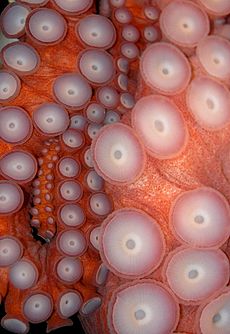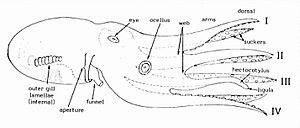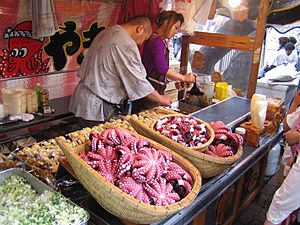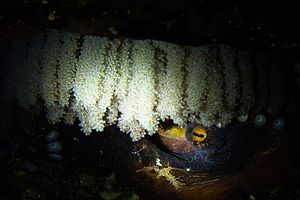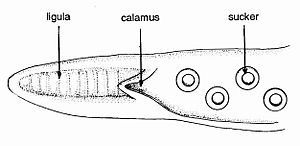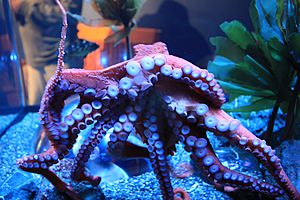North Pacific giant octopus facts for kids
Quick facts for kids North Pacific giant octopus |
|
|---|---|
 |
|
| Scientific classification | |
| Kingdom: | |
| Phylum: | |
| Class: | |
| Order: | |
| Family: |
Octopodidae
|
| Genus: | |
| Binomial name | |
| Enteroctopus dofleini |
|
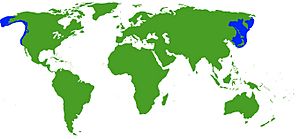 |
|
| Where the giant octopus lives | |
The North Pacific giant octopus (Enteroctopus dofleini) is a very large cephalopod. It lives in the cool coastal waters of the North Pacific. These amazing creatures usually live about 3 to 5 years in the wild.
They mostly eat crabs, shrimp, abalone, fish, and shellfish. This includes scallops, clams, and mussels. In aquariums, they have even been seen eating small sharks. The octopus grabs its food with its strong suckers. Then, it crushes the food using its tough, beak-like mouth. Harbor seals, sea otters, and sperm whales hunt and eat North Pacific giant octopuses.
Contents
Size and Features
All cephalopods, like the octopus, have a body that is the same on both sides (called bilateral symmetry). They have a soft body covered by a mantle, and a well-developed head. Their arms are covered with suckers.
The North Pacific giant octopus has eight arms. Each arm has two rows of suckers. Many suckers have small bumps or hooks to help them stick better. The skin between their arms can stretch out. This forms a parachute-like shape to help them catch prey.
In the middle of its arms is its mouth. Inside the mouth is a hard beak and a radula. The radula is like a toothed tongue.
Cephalopods have two special glands that make a toxin. This toxin helps to paralyze and digest their prey. The octopus breathes by pulling water into its mantle. The water flows over its gills, which take in oxygen. The octopus can also shoot water forcefully out of its siphon. This helps it move quickly through the water, like a jet.
They can reach speeds up to 40 km/h (25 mph) for short bursts. However, they usually move slowly. They often crawl along the bottom using their arms like legs. The siphon is also used to squirt ink. This ink helps them escape from predators.
The octopus's entire body is very flexible. This means it can squeeze through any opening that is just a bit bigger than its beak. The beak is the only hard part of its body. Their arms are very strong and flexible. They can lengthen, shorten, and twist in many ways. Octopuses are cool-blooded, meaning their body temperature changes with the water. They have three hearts and blue blood, which is based on copper.
The octopus's mantle is round. It holds most of the animal's main organs. An octopus can change its skin color very quickly. It does this by making tiny sacs of pigment bigger or smaller. This amazing ability helps it blend into its surroundings.
The North Pacific giant octopus is known for its huge size. Adult octopuses usually weigh around 15 kilograms (33 pounds). Their arm span can reach up to 4.3 meters (14 feet).
What They Eat
North Pacific giant octopuses hunt and eat many different sea creatures. Their diet includes shrimp, crabs, scallops, abalone, cockles, snails, clams, lobsters, and fish. They also sometimes eat other octopuses. They catch food with their suckers. Then, they use their strong "beak" to bite and break it apart.
Who Eats Them
Many creatures try to eat octopus eggs, even when the mother is guarding them. Tiny baby octopuses are eaten by many small ocean animals and filter feeders. Larger marine mammals also rely on the giant Pacific octopus for food. These include harbor seals, sea otters, and sperm whales. Pacific sleeper sharks also hunt these octopuses.
Humans also eat octopuses. They are a big source of protein in many parts of the world. People have caught them for thousands of years. They use lures, spears, traps, nets, and even their bare hands.
Lifespan and Reproduction
The giant Pacific octopus lives longer than many other octopus species. They typically live for 3 to 5 years in the wild. Many other octopuses only live for about one year. To make up for their shorter lives, octopuses lay many eggs. A female can lay between 120,000 and 400,000 eggs. She takes great care of her eggs. During this time, the female stops eating. Her life usually ends soon after the eggs hatch.
The eggs are covered in a protective layer. The female attaches them to a hard surface. She constantly blows water over the eggs. She also cleans them to remove any algae or other growths.
The eggs hatch in about six months. The baby octopuses are tiny, about the size of a grain of rice. Very few of them survive to become adults. They grow incredibly fast. Since they are cool-blooded, they can turn most of the energy from their food into body mass, growth, and reproduction.
Giant Pacific octopuses reproduce only once in their lives before they die. This is called being semelparous.
Intelligence and Behavior
Octopuses are known as the smartest invertebrates (animals without a backbone). Giant Pacific octopuses are often kept in aquariums. This is because of their size and interesting behavior. They have shown that they can recognize humans they see often. For example, they might squirt water or change their skin texture when certain people are nearby.
They can solve simple puzzles and even open childproof bottles. They have also been seen using "tools." The octopus brain has folded parts, which is a sign of complex thinking. They also have special areas for visual and touch memory. They have about 300 million neurons (brain cells).
Octopuses have been known to open tank valves in labs and aquariums. They can even take apart expensive equipment. Some researchers believe they can play and have their own personalities.
|
See also
 In Spanish: Pulpo gigante para niños
In Spanish: Pulpo gigante para niños



